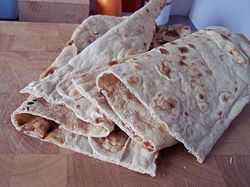Injera
| Injera | |
|---|---|
|
This meal, consisting of injera and several kinds of wat or tsebhi (stew), is typical of Ethiopian and Eritrean cuisine. | |
| Type | Flatbread |
| Place of origin | Ethiopia[1] |
| Associated national cuisine | Djibouti, Eritrea, Ethiopia, Somalia, Sudan, Yemen |
| Main ingredients | Teff flour (sometimes wheat, barley, corn or rice flour) |
| Variations | Canjeero, Lahoh |
|
| |
Injera (Amharic, Tigrinya: እንጀራ ənǧära [ɨndʒəra], sometimes transliterated as enjera; Oromo: bidenaa; Somali: canjeero) is a sourdough-risen flatbread with a unique, slightly spongy texture. Traditionally made out of teff flour,[2] it is a national dish in Ethiopia and Eritrea. A similar variant is eaten in Somalia and Djibouti (where it is called canjeero or lahooh), Yemen (where it is known as lahoh), and Sudan.[3]
Ingredients and cooking method

Injera is usually made from the tiny, iron-rich teff. However, teff production is limited to certain middle elevations and regions with adequate rainfall, so it is relatively expensive for the average household. As many farmers in the Ethiopian highlands grow their own subsistence grain, wheat, barley, corn, and/or rice flour are sometimes used to replace some or all of the teff content. There are also different varieties of injera in Ethiopia, such as nech (white), kay (red) and tikur (black).
In making injera, teff flour is mixed with water and allowed to ferment for several days, as with sourdough starter. As a result of this process, injera has a mildly sour taste. The injera is then ready to be baked into large, flat pancakes. This is done either on a specialized electric stove or, more commonly, on a clay plate (Amharic mittad, Tigrinya mogogo) placed over a fire. Unusual for a yeast or sourdough bread, the dough has sufficient liquidity to be poured onto the baking surface, rather than rolled out. In terms of shape, injera compares to the French crêpe and the Indian dosa as a flatbread cooked in a circle and used as a base for other foods. The taste and texture, however, are unlike the crêpe and dosa, and more similar to the South Indian appam. The bottom surface of the injera, which touches the heating surface, will have a relatively smooth texture, while the top will become porous. This porous structure allows the injera to be a good bread to scoop up sauces and dishes.
Consumption

In Eritrea and Ethiopia, a variety of stews, sometimes salads (during Ethiopian Orthodox fasting, for which believers abstain from most animal products) or simply more injera (called injera firfir), are placed upon the injera for serving. Using one's right hand, small pieces of injera are torn and used to grasp the stews and salads for eating. The injera under these stews soaks up the juices and flavours of the foods and, after the stews and salads are gone, this bread is also consumed. Injera is thus simultaneously food, eating utensil, and plate. When the entire "tablecloth" of injera is gone, the meal is over.
In Somalia, at lunch (referred to as qaddo), the main meal of the day, injera might also be eaten with a stew (maraq) or soup.[4]:113
Contemporary use


In Eritrea and Ethiopia, injera is eaten daily in virtually every household. Preparing injera requires considerable time and resources. The bread is cooked on a large, black, clay plate over a fire. This set-up is a stove called a mitad (ምጣድ) (in Amharic) or mogogo (ሞጎጎ) (in Tigrinya), which is difficult to use, produces large amounts of smoke, and can be dangerous to children. Because of this inefficient cooking method, much of the area's limited fuel resources are wasted. However, in 2003, a research group was given the Ashden award[5] for designing a new type of stove[6] for cooking injera. The new stove uses available fuel sources (including dung, locally called kubet) for cooking injera and other foods efficiently, saving the heat from the fuel. Several parts are made in the central cities of each country, while other parts are molded from clay by women of local areas. However, many women in urban areas now use electric injera stoves, which are topped with a large metal plate. In the United States, injera is most often made on an electric Bethany lefse griddle.
Outside of the Horn of Africa, injera may be found in grocery stores and restaurants specializing in Eritrean, Ethiopian, or Somali foods. Varieties of injera are also eaten in Yemen, as well as Sudan.[1]
See also
References
- ↑ 1.0 1.1 Stanley P. Cauvain, Linda S. Young (2009). The ICC Handbook of Cereals, Flour, Dough & Product Testing: Methods and Applications. DEStech Publications, Inc. p. 216. ISBN 1932078991.
Injera is the fermented pancake-like flatbread, which originated in Ethiopia and neighbouring countries.
- ↑ Science of Bread: Ethiopian injera recipe
- ↑ Burdett, Avani (Avani Burdett). Burdett's Delicatessen Recipes. Springwood emedia. ISBN 1476144621. Check date values in:
|date=(help) - ↑ Mohamed Diriye Abdullahi (2001), "5: Cuisine and Traditional Dress", Culture and customs of Somalia, Culture and Customs of Africa, Westport, CT: Greenwood, ISBN 0-313-31333-4, ISSN 1530-8367, retrieved 2010-08-13,
Injera, known in the north as lahooh, is a thin pancake that is made from batter poured in a circular pattern starting in the center of a hot greased pan..... Sorghum is the preferred flour for making injera, which is common in the countries of the Horn.
- ↑ Ashden awards: injera bread stove
- ↑ Pictures of the improved Injera stoves
External links
| Wikibooks Cookbook has a recipe/module on |
- Mesob Across America: Ethiopian Food in the U.S.A. A book about the history and culture of Ethiopian cuisine
- Ethiopian Food: Mesob Across America A blog about Ethiopian food
- Ethiopian Restaurant Guide Includes video visits to some restaurants
- Ashden awards: injera bread stove
| ||||||||||||||||||
| |||||||||||||||||||||||||
| ||||||||||||||||||

